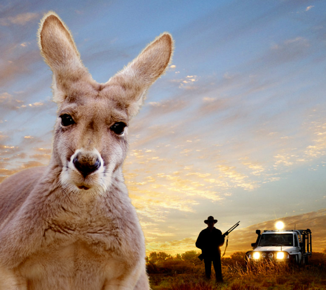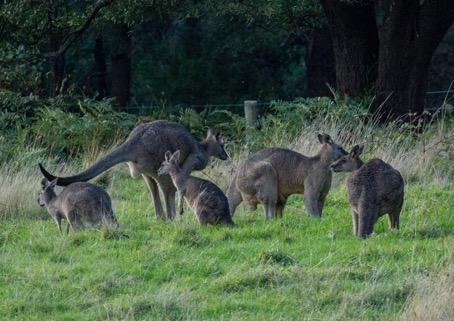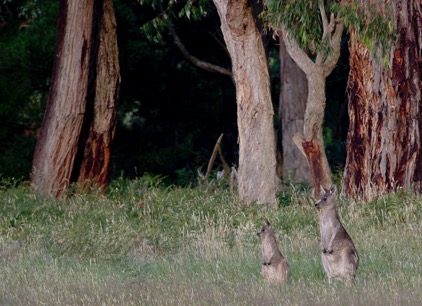Article of the Month – Kangaroos
This is an evolution of the Book of the Month to provide a more diverse set of topics on topics/books/ movies of interest to members.
How many kangaroos do you think there are on the Peninsula (say south and west of Frankston)? Read on for the answer.

Late in May, the Green’s Bush Association screened a special showing of the documentary “Kangaroo: A Love-Hate Story” at the Main Ridge Hall – preceded by a presentation from Mal Brown on the status of Peninsula kangaroos.
The documentary considers kangaroos from a wide range of perspectives. Interviews on the arguments for and against harvesting and culling are interspersed with live footage of spotlight shooting and a particularly harrowing documentation of a couple who moved to an idyllic country retreat only to find themselves under nightly harassment by illegal shooters. The way that it presents spotlighting from the perspective of the kangaroo is particularly memorable.
The movie is deliberately confrontational, Unfortunately, this approach typically leads to a hardening of existing views rather than a solution to the underlying issue. And sadly kangaroo management is one issue that generates strong views for and against.
Personally, I have no problem with hunting for sound reasons like feral removal or food, and given the way we have rearranged the ecological landscape, culling can be an essential component of maintaining a healthy system.
However, the documentary does make strong points on whether the massive approved cull of millions of kangaroos a year is either beneficial or even based on valid evidence. There also are (human) health issues and lack of evidence of a real commercial benefit from culling.
Watching the movie thus led me to question quite a few perceptions that I have held for much of my life on things like the abundance of kangaroos and their impact on pastures and livestock.
So what is the hard evidence for and against kangaroos on the Peninsula? Here is what I gleaned from a short analysis of the scientific literature and documented population surveys.
 Numbers of Peninsula kangaroos: Formal surveys indicate that there are around 2,500-3,000 eastern grey kangaroos remaining on the Peninsula. How did you go with your estimate? I have to admit that I had another zero on the end. The reality is that kangaroos are now essentially extinct across much of our region. Those that remain are concentrated in two localised regions around Greens Bush and up in the Devilbend/Merricks area. Since I live in one of these areas, I plead guilty of the scientific sin of extrapolating from an unrepresentative sample.
Numbers of Peninsula kangaroos: Formal surveys indicate that there are around 2,500-3,000 eastern grey kangaroos remaining on the Peninsula. How did you go with your estimate? I have to admit that I had another zero on the end. The reality is that kangaroos are now essentially extinct across much of our region. Those that remain are concentrated in two localised regions around Greens Bush and up in the Devilbend/Merricks area. Since I live in one of these areas, I plead guilty of the scientific sin of extrapolating from an unrepresentative sample.
These low numbers mean that the eastern grey kangaroo is in the vicinity of becoming a threatened species on the Peninsula.
Impact on livestock: Kangaroos and livestock only graze on the same herbage when the total grazing exceeds dry matter production. This is common in dryland farming, but rare on the Peninsula. Let’s take the extreme case where stock and kangaroos are directly competing against each other. Then one horse, steer, or sheep consumes about the same as 22, 15, or 2.5 kangaroos, respectively (Dawson and Nunn 2007). Other, unpublished estimates vary between 1.5 and 5 kangaroos per sheep with cattle and horses scaled accordingly.
Put another way, 120 horses eat as much as the entire population of Peninsula kangaroos!
Beef production example: There are 15-20 thousand head of cattle on the Peninsula (MPB 2016), so if all the kangaroos lived exclusively on beef properties and ate only prime grass, they would cause less than a 1% loss in production.
Normally on the Peninsula there is little to no fodder competition in good pastureland. Further, kangaroos are spread across un-stocked properties and the 40% of the Peninsula covered by parks and reserves. Thus, the above estimates are on the upper extreme and the logical conclusion is that there is negligible real loss to beef production from kangaroos. These general findings are similar for other stock.
Other impacts: There is no doubt that kangaroo habits of using the same tracks up and down the hills in going to and from water/food can result in some erosion. But this is minor compared to the degradation of pastures due to compaction and erosion from cattle and sheep (O’Brien 2001). They also push through and under fences, with resulting damage – a problem that can easily be fixed by providing access points along fences.
Kangaroo vs rabbit: A kangaroo eats about the same as 5-6 rabbits. However, rabbits are in far greater numbers, are widespread, and preferentially eat high value pasture (especially legumes), leading to them having a substantially greater real impact than kangaroos.
Kangaroo as meat: Let’s consider the alternative – remove all beef and sheep and exclusively cultivate kangaroos. Unfortunately, that will not work as they produce too little meat too slowly. To replace Australian beef production with kangaroos, for example, would require us killing the entire Australian population 40 times over every year (e.g. O’Brien 2001).
Net value to the Peninsula: The economic value of Peninsula tourism is greater than that for agriculture (in 2015-16, tourism derived $262m vs $210 m for agriculture forestry and fishing – MPB 2016). A web search for ‘Kangaroo, Mornington Peninsula’ provides page after page advertising kangaroos as a major attraction. Every visitor to our place also wants to see a mob of kangaroos. Thus, although there appears to be no published information, it is reasonable to assume that the value of our small population of kangaroos to Peninsula tourism industry is far greater than their small negative impact on agriculture.

For myself? Even after all these years I still get a thrill when I see kangaroos from the window in the early morning, or a swampy browsing down in the bushland.
Want to see the Movie? It can be obtained from https://kangaroothemovie.com/. A copy also is available for Landcare members – please contact me at gholland@carranya.net and I will pass on your interest.
References:
Dawson, T. J., and A.J. Munn, 2007: How much do kangaroos of differing age and size eat relative to domestic stock?: implications for the arid rangelands. In C. Dickman, D. Lunney & S. Burgin (Eds.), Animals of Arid Australia: Out on Their Own? (pp. 96-101). Australia: Royal Zoological Society of New South Wales. Available at: https://ro.uow.edu.au/cgi/viewcontent.cgi?article=3186&context=smhpapers
O’Brien, P., 2001: Kangaroos and land degradation. Greenleft Weekly issue 472. Available at: https://www.greenleft.org.au/content/kangaroos-and-land-degradation
MPB 2016: https://www.mpbusiness.com.au/wp-content/uploads/2016/10/2014-Agricultural-Audit_FINAL.pdf
- Article and images by Greg Holland; movie flyer from the above URL; thanks to Virginia Carter for coordinating the showing of the movie.